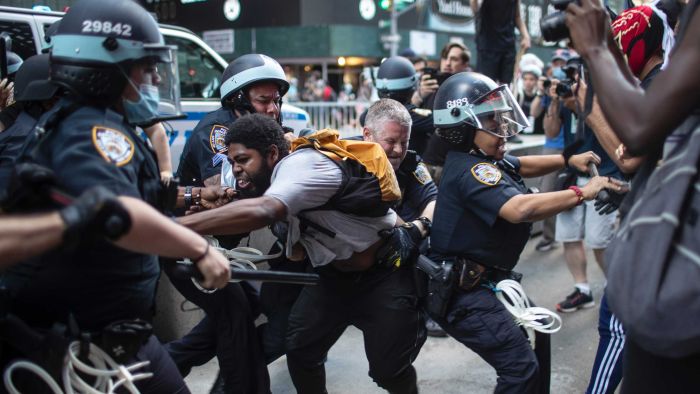Civil unrest has flared and curfews have been imposed in several major US cities as protesters continue to vent their outrage over the death of a black man shown on video gasping for breath as a white Minneapolis policeman knelt on his neck.
Key points:
- Minnesota Governor Tim Walz has not yet requested the support of the military from the Pentagon
- The Governor said agitators including white supremacists were using George Floyd’s death to sow chaos
-
Tens of cities across the US have seen often violent protests in the wake of Mr Floyd’s death
From Los Angeles to Miami to Chicago, protests marked by chants of “I can’t breathe” — a rallying cry echoing the dying words of George Floyd — began peacefully before turning unruly as demonstrators blocked traffic, set fires and clashed with riot police, some firing tear gas and plastic bullets into crowds.
The sight of protesters flooding streets fuelled a sense of crisis in the United States after weeks of lockdowns due to the coronavirus pandemic, which has seen millions thrown out of work and has disproportionately affected minority communities.
Authorities are investigating “multiple shootings”, including one that left a person dead, in downtown Indianapolis.
Indianapolis Metropolitan Police Chief Randal Taylor confirmed the shootings during a late-night news conference, but did not offer any more details. Police later tweeted that no officers were involved.
LA authorities said a police officer was undergoing surgery for a fractured skull after he was hit with a bottle thrown at him while he sat in a car moving through an intersection.
In the nation’s capital, hundreds of demonstrators assembled near the Justice Department headquarters shouting, “Black lives matter”.
Many later moved to the White House, where they faced off with shield-carrying police, some mounted on horseback.
President Donald Trump said if protesters who gathered the night before in Lafayette Square, across from the White House, had breached the fence, “they would have been greeted with the most vicious dogs, and most ominous weapons, I have ever seen”.

The full Minnesota National Guard was activated for the first time since World War II after four nights of arson, looting and vandalism in parts of Minneapolis, the state’s largest city, and its adjacent capital, St Paul.
Governors in several other states also called in National Guard troops as protests over repeated police killings of black people grew from New York to Tulsa to Los Angeles, where police fired rubber bullets to scatter crowds and at least one police car burned.
The protests, which began in Minneapolis following Monday’s (local time) death of George Floyd after a police officer pressed his knee on Mr Floyd’s neck for more than eight minutes, have left parts of that city a grid of broken windows, burned-out buildings and ransacked stores.
But the demonstrations have since become a national phenomenon, as protesters decry years of deaths at police hands.

Minnesota Governor Tim Walz said the full National Guard deployment was necessary because outside agitators were using protests over the death of Mr Floyd to sow chaos, and that he expected Saturday night’s demonstrations to be the fiercest so far.
“We are under assault,” Mr Walz, a first-term governor elected from Minnesota’s Democratic-Farmer-Labor Party, told a briefing.
“Order needs to be restored … we will use our full strength of goodness and righteousness to make sure this ends.”
Separately, US Attorney-General William Barr also pointed the finger at extremist instigators, though he and Mr Walz — neither offering evidence to support their assertions — suggested opposite ends of the political fringe were to blame.
The unrest comes at a time when most Americans have spent months inside over concerns surrounding the coronavirus, which Mr Trump has called an “invisible enemy”.


